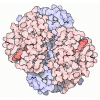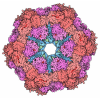[English] 日本語
 Yorodumi
Yorodumi- PDB-1odp: PEPTIDE OF HUMAN APOA-I RESIDUES 166-185. NMR, 5 STRUCTURES AT PH... -
+ Open data
Open data
- Basic information
Basic information
| Entry | Database: PDB / ID: 1odp | ||||||
|---|---|---|---|---|---|---|---|
| Title | PEPTIDE OF HUMAN APOA-I RESIDUES 166-185. NMR, 5 STRUCTURES AT PH 6.6, 37 DEGREES CELSIUS AND PEPTIDE:SDS MOLE RATIO OF 1:40 | ||||||
 Components Components | APOA-I PEPTIDE | ||||||
 Keywords Keywords | LIPID TRANSPORT /  APOLIPOPROTEIN A-I / COFACTOR FOR LCAT ACTIVATION APOLIPOPROTEIN A-I / COFACTOR FOR LCAT ACTIVATION | ||||||
| Function / homology |  Function and homology information Function and homology informationDefective ABCA1 causes TGD / high-density lipoprotein particle receptor binding / Scavenging by Class B Receptors / HDL clearance / spherical high-density lipoprotein particle / positive regulation of hydrolase activity / regulation of intestinal cholesterol absorption / negative regulation of response to cytokine stimulus / protein oxidation / vitamin transport ...Defective ABCA1 causes TGD / high-density lipoprotein particle receptor binding / Scavenging by Class B Receptors / HDL clearance / spherical high-density lipoprotein particle / positive regulation of hydrolase activity / regulation of intestinal cholesterol absorption / negative regulation of response to cytokine stimulus / protein oxidation / vitamin transport / high-density lipoprotein particle binding / cholesterol import /  ABC transporters in lipid homeostasis / negative regulation of heterotypic cell-cell adhesion / blood vessel endothelial cell migration / apolipoprotein receptor binding / negative regulation of cell adhesion molecule production / negative regulation of cytokine production involved in immune response / apolipoprotein A-I receptor binding / HDL assembly / peptidyl-methionine modification / negative regulation of very-low-density lipoprotein particle remodeling / phosphatidylcholine biosynthetic process / glucocorticoid metabolic process / Chylomicron remodeling / phosphatidylcholine-sterol O-acyltransferase activator activity / phosphatidylcholine metabolic process / positive regulation of phospholipid efflux / ABC transporters in lipid homeostasis / negative regulation of heterotypic cell-cell adhesion / blood vessel endothelial cell migration / apolipoprotein receptor binding / negative regulation of cell adhesion molecule production / negative regulation of cytokine production involved in immune response / apolipoprotein A-I receptor binding / HDL assembly / peptidyl-methionine modification / negative regulation of very-low-density lipoprotein particle remodeling / phosphatidylcholine biosynthetic process / glucocorticoid metabolic process / Chylomicron remodeling / phosphatidylcholine-sterol O-acyltransferase activator activity / phosphatidylcholine metabolic process / positive regulation of phospholipid efflux /  lipid storage / phospholipid homeostasis / lipid storage / phospholipid homeostasis /  Chylomicron assembly / positive regulation of cholesterol metabolic process / high-density lipoprotein particle remodeling / high-density lipoprotein particle clearance / phospholipid efflux / cholesterol transfer activity / Chylomicron assembly / positive regulation of cholesterol metabolic process / high-density lipoprotein particle remodeling / high-density lipoprotein particle clearance / phospholipid efflux / cholesterol transfer activity /  reverse cholesterol transport / cholesterol transport / reverse cholesterol transport / cholesterol transport /  chemorepellent activity / high-density lipoprotein particle assembly / very-low-density lipoprotein particle / positive regulation of CoA-transferase activity / lipoprotein biosynthetic process / high-density lipoprotein particle / endothelial cell proliferation / chemorepellent activity / high-density lipoprotein particle assembly / very-low-density lipoprotein particle / positive regulation of CoA-transferase activity / lipoprotein biosynthetic process / high-density lipoprotein particle / endothelial cell proliferation /  regulation of Cdc42 protein signal transduction / triglyceride homeostasis / HDL remodeling / cholesterol efflux / Scavenging by Class A Receptors / regulation of Cdc42 protein signal transduction / triglyceride homeostasis / HDL remodeling / cholesterol efflux / Scavenging by Class A Receptors /  cholesterol binding / negative regulation of interleukin-1 beta production / positive regulation of Rho protein signal transduction / negative chemotaxis / adrenal gland development / cholesterol biosynthetic process / endocytic vesicle / positive regulation of cholesterol efflux / negative regulation of tumor necrosis factor-mediated signaling pathway / Scavenging of heme from plasma / positive regulation of phagocytosis / positive regulation of substrate adhesion-dependent cell spreading / Retinoid metabolism and transport / positive regulation of stress fiber assembly / endocytic vesicle lumen / cholesterol binding / negative regulation of interleukin-1 beta production / positive regulation of Rho protein signal transduction / negative chemotaxis / adrenal gland development / cholesterol biosynthetic process / endocytic vesicle / positive regulation of cholesterol efflux / negative regulation of tumor necrosis factor-mediated signaling pathway / Scavenging of heme from plasma / positive regulation of phagocytosis / positive regulation of substrate adhesion-dependent cell spreading / Retinoid metabolism and transport / positive regulation of stress fiber assembly / endocytic vesicle lumen /  heat shock protein binding / cholesterol metabolic process / cholesterol homeostasis / integrin-mediated signaling pathway / heat shock protein binding / cholesterol metabolic process / cholesterol homeostasis / integrin-mediated signaling pathway /  Post-translational protein phosphorylation / Post-translational protein phosphorylation /  regulation of protein phosphorylation / regulation of protein phosphorylation /  phospholipid binding / Heme signaling / PPARA activates gene expression / negative regulation of inflammatory response / Regulation of Insulin-like Growth Factor (IGF) transport and uptake by Insulin-like Growth Factor Binding Proteins (IGFBPs) / phospholipid binding / Heme signaling / PPARA activates gene expression / negative regulation of inflammatory response / Regulation of Insulin-like Growth Factor (IGF) transport and uptake by Insulin-like Growth Factor Binding Proteins (IGFBPs) /  extracellular vesicle / Platelet degranulation / extracellular vesicle / Platelet degranulation /  amyloid-beta binding / cytoplasmic vesicle / collagen-containing extracellular matrix / secretory granule lumen / blood microparticle / protein stabilization / amyloid-beta binding / cytoplasmic vesicle / collagen-containing extracellular matrix / secretory granule lumen / blood microparticle / protein stabilization /  early endosome / G protein-coupled receptor signaling pathway / Amyloid fiber formation / early endosome / G protein-coupled receptor signaling pathway / Amyloid fiber formation /  endoplasmic reticulum lumen / endoplasmic reticulum lumen /  signaling receptor binding / signaling receptor binding /  enzyme binding / protein homodimerization activity / enzyme binding / protein homodimerization activity /  extracellular space / extracellular exosome / extracellular region / identical protein binding / extracellular space / extracellular exosome / extracellular region / identical protein binding /  plasma membrane / plasma membrane /  cytosol cytosolSimilarity search - Function | ||||||
| Biological species |   Homo sapiens (human) Homo sapiens (human) | ||||||
| Method |  SOLUTION NMR SOLUTION NMR | ||||||
 Authors Authors | Wang, G. / Treleaven, W.D. / Cushley, R.J. | ||||||
 Citation Citation |  Journal: Biochim.Biophys.Acta / Year: 1996 Journal: Biochim.Biophys.Acta / Year: 1996Title: Conformation of human serum apolipoprotein A-I(166-185) in the presence of sodium dodecyl sulfate or dodecylphosphocholine by 1H-NMR and CD. Evidence for specific peptide-SDS interactions. Authors: Wang, G. / Treleaven, W.D. / Cushley, R.J. | ||||||
| History |
|
- Structure visualization
Structure visualization
| Structure viewer | Molecule:  Molmil Molmil Jmol/JSmol Jmol/JSmol |
|---|
- Downloads & links
Downloads & links
- Download
Download
| PDBx/mmCIF format |  1odp.cif.gz 1odp.cif.gz | 33.9 KB | Display |  PDBx/mmCIF format PDBx/mmCIF format |
|---|---|---|---|---|
| PDB format |  pdb1odp.ent.gz pdb1odp.ent.gz | 26.1 KB | Display |  PDB format PDB format |
| PDBx/mmJSON format |  1odp.json.gz 1odp.json.gz | Tree view |  PDBx/mmJSON format PDBx/mmJSON format | |
| Others |  Other downloads Other downloads |
-Validation report
| Arichive directory |  https://data.pdbj.org/pub/pdb/validation_reports/od/1odp https://data.pdbj.org/pub/pdb/validation_reports/od/1odp ftp://data.pdbj.org/pub/pdb/validation_reports/od/1odp ftp://data.pdbj.org/pub/pdb/validation_reports/od/1odp | HTTPS FTP |
|---|
-Related structure data
- Links
Links
- Assembly
Assembly
| Deposited unit | 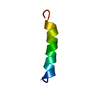
| |||||||||
|---|---|---|---|---|---|---|---|---|---|---|
| 1 |
| |||||||||
| NMR ensembles |
|
- Components
Components
| #1: Protein/peptide | Mass: 2336.605 Da / Num. of mol.: 1 / Fragment: RESIDUES 166 - 185 Source method: isolated from a genetically manipulated source Source: (gene. exp.)   Homo sapiens (human) / References: UniProt: P02647 Homo sapiens (human) / References: UniProt: P02647 |
|---|
-Experimental details
-Experiment
| Experiment | Method:  SOLUTION NMR SOLUTION NMR |
|---|
- Sample preparation
Sample preparation
| Sample conditions | pH: 6.6 / Temperature: 310 K |
|---|---|
Crystal grow | *PLUS Method: other / Details: NMR |
- Processing
Processing
| NMR software |
| |||||||||
|---|---|---|---|---|---|---|---|---|---|---|
| NMR ensemble | Conformer selection criteria: MOST CLOSELY RESEMBLING THE AVERAGE STRUCTURE OF OF A CALCULATED SET OF 20 CONFORMERS Conformers calculated total number: 20 / Conformers submitted total number: 5 |
 Movie
Movie Controller
Controller


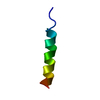
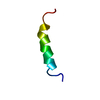

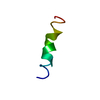


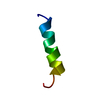

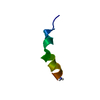
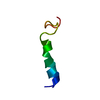
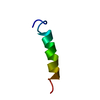

 PDBj
PDBj

